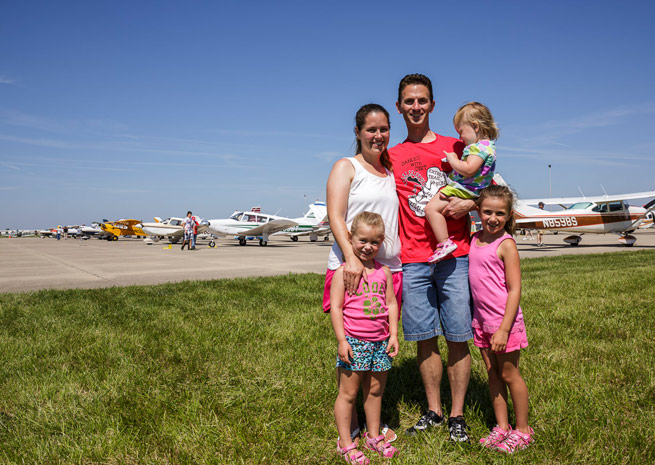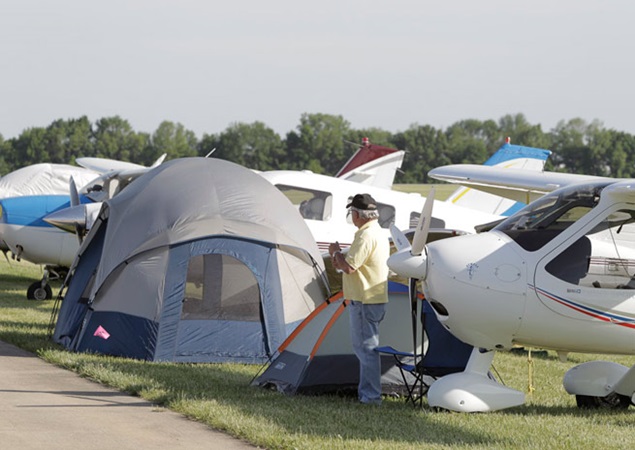A conga line of aircraft was already in sequence for arrival on Runway 7 at Indianapolis Regional Airport before 8 a.m. May 31 for the second AOPA Regional Fly-In of the year. Thanks to perfect weather—clear skies, temperatures in the 80s, and a light breeze, more than 2,000 attended the event, including 160 volunteers, with 475 aircraft flying in to the airport, and more than 60 to Indianapolis Metropolitan, the designated reliever.
A family affair

“This is awesome,” student pilot Brent Fazekas said as he walked through the aircraft parking area with his wife, Kristin, and their three young daughters Kameryn, Kara, and Emily. Fazekas has taken three flight lessons, and just flew to Indianapolis Regional from nearby Noblesville, Ind., the day before with his instructor, but drove his family in for this general aviation experience. “I hope he’s as gentle driving an airplane as he is driving a car,” Kristin said. Fazekas is learning to fly a Cessna 172 but will need to step up to an aircraft with more seats later—they have another child on the way.
The fly-in was a family affair for attendees—husband-and-wife pairs, three generations proudly walking side by side, sons treating fathers to a day out, and young families spending time together.
That’s why Mackenzie Rose, 14, likes to fly with her grandfather Ken Talhelm in his V-tail Bonanza. The two are usually accompanied by her nine-year-old brother as they travel to fly-ins and airshows, and camp at EAA AirVenture. Talhelm, a pilot at Muncie Aviation, lets Mackenzie take the controls of the Bonanza. And, while she loves flying and wants to be a pilot someday, she said that she likes attending these events to “spend time with grandpa.”

Austin Malcomb flew an Experimental Vans Aircraft RV-12 that he helped build in with his father, and met his grandfather, also a pilot, at the fly-in. Malcomb of North Vernon, Ind., earned his private pilot certificate on Jan. 4, his seventeenth birthday. He worked on and trained in the aircraft through Eagle’s Nest, a program in seven states that works with high schools to place an RV-12 kit for students to build and get three hours of college credit with Embry-Riddle Aeronautical University, Purdue University, or Liberty University. (See “Pulling together” in the May 2013 AOPA Pilot). Malcomb recruited his friend Jacob Lofgreen to help build one kit, and now a second, and both plan to pursue airframe-and-powerplant certification after high school. Lofgreen is studying for his written exam and said that flying the aircraft beats building it.

“You kind of feel like a miracle maker,” Lofgreen said of flying an airplane that he built. “It becomes your baby.” Students at the North Vernon Eagle’s Nest program received free flight instruction and checkrides (time donated by the CFI and an examiner).
Second chances
Clyde Downs of Port Huron, Mich., flew in a day early and camped out under his 1970 Cessna 172’s wing. Downs shared the ups and downs of his aviation story with nearby campers. He had learned to fly in 1970, earning his private and commercial certificates and instrument rating. Then, “I went broke,” he recalled. “Thirty-five years later, I bought an airplane. That’s three years ago.” The brownish-gold airplane, N-number 7356G, is remarkably similar to the first airplane he owned, he said: same make and model, same color scheme, and a close N-number, 7310G.
He said that he studied materials from the Air Safety Institute, FAA, and others to get back up to speed.
While he shared his comeback story in the camping area, more than 90 rusty pilots on the other end of the field were learning that it’s not as difficult as it seems to get back in aviation. During the Rusty Pilots seminar May 30, they covered everything needed to qualify for completing the ground portion of the FAA flight review, and many signed up for some lessons with IndyJet, the FBO and flight school on the field, to get back in the air.
During a Pilot Town Hall, AOPA President Mark Baker said that on average, those who attend AOPA’s Rusty Pilot seminars have been out of aviation for about seven years.
Advocacy efforts to get pilots back in the air

Baker and U.S. Rep. Todd Rokita (R-Ind.) spoke about the third class medical exemption effort—a popular topic among pilots because it would eliminate the third class medical requirement for certain flight operations. The House bill, sponsored by Rokita and Rep. Sam Graves (R-Mo.), would allow pilots to make noncommercial VFR flights in aircraft weighing up to 6,000 pounds with no more than six seats without a third class medical. The bill also would let pilots carry up to five passengers, fly at altitudes below 14,000 feet msl, and fly no faster than 250 knots. It would require the FAA to report on the safety consequences of the new rule after five years. Now the bill has 112 co-sponsors, they announced at the Pilot Town Hall. The Senate version of the bill is also gaining co-sponsors, Rokita said. He credited the support for the bills to AOPA members’ active involvement in contacting their members of Congress and donating to the AOPA Political Action Committee.
“AOPA membership has not been bashful, thankfully,” about makings its voice heard on the third class medical issue, Rokita said. Other elected officials at the Pilot Town Hall—U.S. Sen. Joe Donnelly, U.S. Rep. Larry Bucshon, and Indiana Sen. Brandt Hershman—echoed Rokita’s sentiment and thanked AOPA members for being a force to be reckoned with.
Pilots’ participation in garnering support for legislation to benefit general aviation may stem from their passion for flying—a passion that can be instilled at any age, as Lofgreen demonstrated. Learning to fly and build an airplane would be out of reach for the teenager if it weren’t for the Eagle’s Nest program. “Nothing’s going to stop us,” he said. “There’s always a way, a solution around it.”














